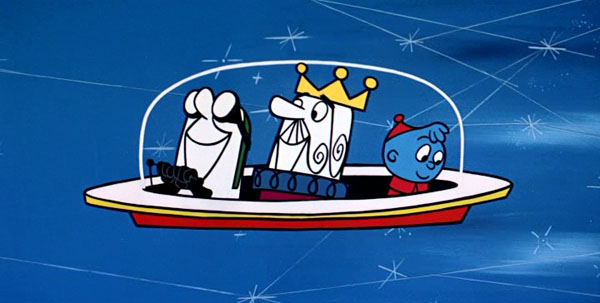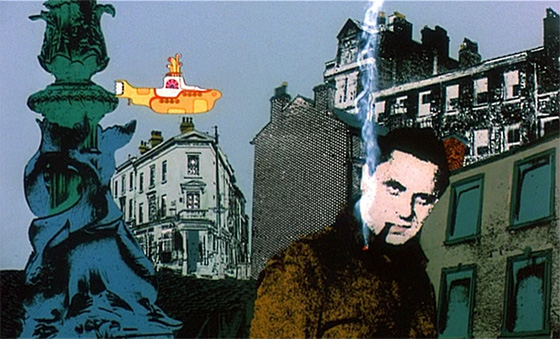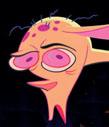
Bill Scott. According to Advertising Age July 12, 1993 1963, Jay Ward and Bill Scott of Jay Ward Productions work “in a casual manner” in the bedroom of an old Hollywood apartment. There is a five gallon jar of jelly beans The room is crammed to the rafters with miscellaneous objects –tiki gods, old puppet and funny hats “which seem to help us” said Scott. “We are commonplace square Johns so we were forced to invent an exotic adventurous member of the company – a dashing rogue named Ponsonby Britt – to give a dash of color to the organization.
“Compton Advertising came to us with the name Cap’n Crunch. We developed the character – the bumbling little old man 500 years old who sailed the seven seas all his life with his crew of bright young kids. Based on our character, the Quaker Oats people were requested to develop the crunchiest cereal they could make. We made our commercials as much like entertainment cartoons as possible with the sales message limited to one line.”
Off to the side is an old TV set. Scott said, “Jay won’t have a desk. He works standing up, off the top of the TV. We have fun and games all the time. We have a great staff. They just come up with some very funny things. We have no taboos. Everything goes.”
Toons and Toys. “If I come into a television station in Los Angeles with a great show, they say ‘Thank you very much, goodbye’,” said Andrew Heyward president of DIC Enterprises in the Wall Street Journal May 12, 1987. “But if we go in and say, ‘Hey, we’ve got a hot toy line coming out from Mattel and normally they spend seven million dollars in your market on spot advertising’, then that’s a different story.”
“You have a home run if you create a fabulous show and also get merchandising and advertising support,” said Gary Krisel, president of Disney’s network television operations in the same article. “But if you start with merchandising and advertising as your basis for creating a show, you aren’t going to get the same quality.”

From UPA’s “Gerald McBoing Boing on The Planet Moo” (1956) directed by Robert Cannon
It’s a Cartoon. In Sight and Sound magazine Summer 1956, the writer shares the story of UPA director Robert Cannon going to a Los Angeles theater to see an animated cartoon he had done and to judge the audience’s reaction. The couple in front of him was overcome with “bewilderment” that led into a heated discussion. One of them finally turned “in triumph” to the other and said, “I know what it is – it’s a cartoon!”
Real People in Yellow Submarine. In the “Eleanor Rigby” segment of the animated feature film Yellow Submarine (1968), some real people make an appearance. The man trying to escape from the phone booth is the owner of the animators’ favorite pub, The Dog and Duck. The fellow in the motorcycle helmet with a tear running down his goggles was the handicapped messenger boy at the pub, Brian Endel. On the roof tops, the two umbrella holding gentlemen are director George Dunning and Art Director Heinz Edlemann. All the football/soccer players are photographs of animator Tony Cuthbert.

The woman who might be Eleanor Rigby carrying a fish bowl was background artist Alison DeVere. Al Brodax, pipe in mouth, (above) is seen in one of the alleys of Liverpool. According to Brodax, Old Fred was modeled after a waiter at Wheelers, another favorite drinking hangout of the animators, but Special Effects Designer Charlie Jenkins who designed the scene said that Old Fred was modeled after Jack Stokes, the animation director for the Pepperland scenes. In the Sea of Time, the man in a derby hat holding a pocket watch is watercolorist Ian Cowan who worked closely with Heinz Edelman on the film’s backgrounds.
Disney Changes. The Fox and the Hound (1981) was a troubled production. The original ending for the animated feature was to have the hard drinking hunter nailing Tod the fox’s lifeless pelt to the wall and then euthanizing Copper the dog with his shotgun.
In the film, Chief the old dog gets hit by a freight train and drops a thousand feet into a gorge. CEO Ron Miller and co-director Art Stevens didn’t like that so had animator Randy Cartwright go back to the scene where Copper finds Chief’s body and had him animate Chief’s eyes opening and closing so he could show up later. Storyman Vance Gerry was upset and pointed out the dog had been hit directly by the freight train to no avail.
Producer Woolie Reitherman wanted to add a sequence about three quarters into the movie where Phil Harris and Charo would voice two whooping cranes singing a silly song. When he was overruled, he went into a friend’s office and dejectedly said, “I don’t know…maybe this is a young man’s medium now…”
 Kricfalusi on Ren. In the Los Angeles Times Calendar section for August 9, 1992 animator and director John Kricfalusi talked about the character of Ren in the Ren and Stimpy television series. “Originally Ren was just completely a psychotic, manic-depressive, insane over-the top unpredictable character. I didn’t want to fall into the pathos trap, where you just plug pathos into an episode – the Jerry Lewis syndrome. But we added a softer side to Ren, a warmer side to Ren and Stimpy’s relationship and that came from Vanessa (Coffey, Nickelodeon’s executive producer of animation).
Kricfalusi on Ren. In the Los Angeles Times Calendar section for August 9, 1992 animator and director John Kricfalusi talked about the character of Ren in the Ren and Stimpy television series. “Originally Ren was just completely a psychotic, manic-depressive, insane over-the top unpredictable character. I didn’t want to fall into the pathos trap, where you just plug pathos into an episode – the Jerry Lewis syndrome. But we added a softer side to Ren, a warmer side to Ren and Stimpy’s relationship and that came from Vanessa (Coffey, Nickelodeon’s executive producer of animation).
“Jackie Gleason did a great job at that, being funny and pathetic at the same time. I’d laugh my guts out after he’d scream at Alice and then realize he was wrong.”
Sounds Different. In 1960, a Hanna-Barbera character record was released as part of the Talking Movie Wheels series. On one side is a story of Yogi Bear and on the other one of Huckleberry Hound. There is a little window on the cover and a giant disc (Dial-O-Matic) inside with illustrations so that as you listen, you spin the disc to reveal the illustrations one picture at a time to match the story. Why is this an anecdote? All the character voices on the record are done by Jack Mercer, better known as the voice of Popeye. Narration by Jim Sparks. Written and produced by Paul White and Ruth Roche for Radio Printing Corp. of Bridgeport, Connecticut. Recorded by Lee Olsen. My good friend Greg Ehrbar told me that one other record was made in the Movie Wheels format and featured Felix the Cat with Mercer doing the voice. He wrote more about this odd record series here.


 Jim Korkis is an internationally respected animation historian who in recent years has devoted his attention to the many worlds of Disney. He was a columnist for a variety of animation magazines. With his former writing partner, John Cawley, he authored several animation related books including The Encyclopedia of Cartoon Superstars, How to Create Animation, Cartoon Confidential and Get Animated’s Animation Art Buyer’s Guide. He taught animation classes at the Disney Institute in Florida as well as instructing classes on acting and animation history for Disney Feature Animation: Florida.
Jim Korkis is an internationally respected animation historian who in recent years has devoted his attention to the many worlds of Disney. He was a columnist for a variety of animation magazines. With his former writing partner, John Cawley, he authored several animation related books including The Encyclopedia of Cartoon Superstars, How to Create Animation, Cartoon Confidential and Get Animated’s Animation Art Buyer’s Guide. He taught animation classes at the Disney Institute in Florida as well as instructing classes on acting and animation history for Disney Feature Animation: Florida.




















































Not only DiC was thinking about the “Hot Toy Craze” philosophy (With Rainbow Brite which was one of the biggest show but a popular animated feature film as well and Captain N and the Super Mario Bros.) but other animation studios as well, like Filmation’s He-Man & She Ra, Hasbro’s Transformers,G.I.Joe,My Little Pony and JEM, Saban’s Maple Town (only in The Western Hemisphere since other countries didn’t pick up the Saban version but air the original version instead).
But sometime if you have a show base on a hot toy you need to have to have a good Animation unlike Marvel who had Dungeons and Dragons which was one of popular Role Playing which had a “dark ride” type attraction at a amusement park where the principal characters went through instead of a enchanted game piece that took them to the D&D realm (Dexter’s Labratory had a better parody of D&D called D&DD which Dex and his friends were playing a D&D based game called Monsters and Mazes and of course Dee Dee wanted to play even tho Dexter objected to it) and DiC’s Sylvainian Families which was cel animated instead of Stop Motion Animated like the commercials and sadly the animation was in my opinion quite sloppy and the storyline was bad.
Typo in Bill Scott entry I think…shouldn’t the date be 1963, not 1993 (unless it was a reprint of a retro article)? Other than that, I always enjoy Jim’s anecdotes pieces!!
Interesting that the Cap’n Crunch character was devised first, and then the cereal was created.